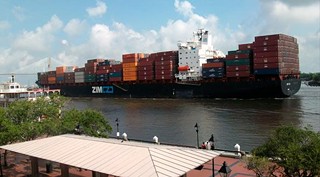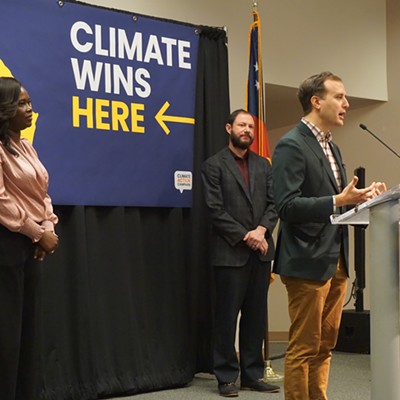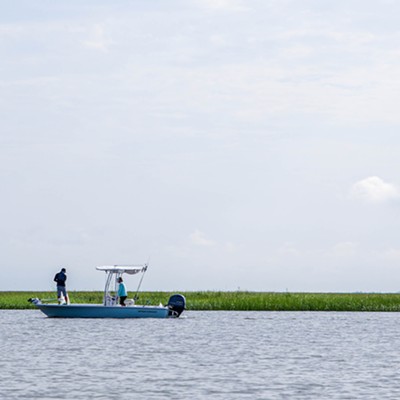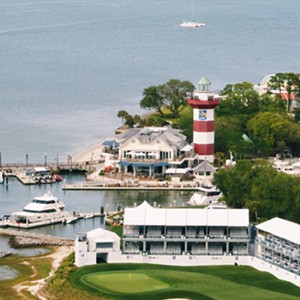Editor’s Note — There have been a lot of developments in the past few weeks regarding the planned (and still controversial) deepening of the Savannah River. To get you up to speed we present this special report by Dan McCue, veteran reporter on coastal environmental and economic issues.
Last week’s decision by South Carolina environmental regulators that the planned deepening of the Savannah Harbor can go forward without their resistance may have cheered the Georgia Ports Authority and the U.S. Army Corps of Engineers.
But it’s done little to mollify the project’s critics, and the game is far from over.
Last week, at the request of the Corps, the board that oversees South Carolina’s Department of Health and Environmental Control (DHEC) unanimously endorsed the dredging project after learning of an eleventh hour “deal” that agency staffers said resolved the Palmetto State’s qualms.
Six weeks earlier the agency informed the Corps that its staff had recommended rejecting the project’s water quality certification and also a consistency determination under the Coastal Zone Management Act.
But just as the board was convening to reconsider the agency’s position, DHEC lawyer John Harleston announced that the three governmental parties to what had morphed into a bi–state spat had finally come to a meeting of the minds.
The agreement doesn’t change the scope or any other aspect of the project, but rather clarifies one of the few aspects that even the Corps had long acknowledged as up in the air: Who would pay for the ongoing operation and maintenance of special pumps to be installed in the project zone to pump oxygen into the water for the benefit of aquatic species.
The initial cost of installing the devices, called Speece cones, was already included in the project budget. However, subsequent funding for the pumps’ ongoing operation and maintenance has been a significant cause of concern — especially in a political and economic climate in Washington D.C. where cost–cutting and deficit reduction are suddenly high priorities.
Under the deal reached last Thursday, Georgia has agreed to pay all or part of the estimated $1.2 million annual price of keeping pumps going any year federal appropriations to the Corps for that purpose fall short.
But even as they voted to give their blessing to the project, S.C. DHEC board seemed well aware that many people, including environmentalists who have long been vocal opponents of the project, would be unhappy with the decision.
After the vote, board chairman Allen Amsler disputed a reporter’s characterization of the vote as a reversal of course for the agency.
Instead, he said, the vote was an indication that the agency’s processes worked. The staff had presented issues of concern which were ultimately resolved by the parties, he explained.
“Frankly, I was surprised by what occurred at the meeting, and our concern is that S.C. DHEC staff reached a resolution without addressing the specific issues that were identified in the proposed denial,” said Chris DeScherer, senior attorney at the Southern Environmental Law Center.
DeScherer said DHEC staff had questioned whether, from a mechanical perspective, the Speece cones would effectively oxygenate the river.
“Based on what we know right now, there’s nothing in this agreement that seems to address that point,” he said.
In addition, DeScherer said, S.C. DHEC staff questioned whether the Corps had adequately evaluated alternatives to the dredging project.
Still, the S.C. DHEC board has signalled that it will approve water quality certification for the deepening.
“That may shed more light on who got what in the deal,” DeScherer said. “Once we get it, we’ll sit down and evaluate it and talk to our clients about it and see what the next step is.”
The anticipated next step for the Southern Environmental Law Center would be to file an appeal of the board’s decision and take the matter before an administrative law judge.
“To me, the only thing that could explain this decision is that it was a political deal, pure and simple,” DeScherer said.
Breaking news has added yet another wrinkle. This past Monday, the S.C.-based Savannah River Maritime Commission asked the S.C. attorney general to represent them in a legal challenge to DHEC, saying that DHEC’s approval last week of the Corps water permit was “issued improperly and has no effect of law.”
What happens next — whether in court, in the S.C. Legislature, or both — no one is sure. But the Savannah River harbor deepening appears to have run aground again, at least temporarily.
‘Roughshod’ over states
In the weeks between South Carolina’s initial rebuke of the Savannah Harbor deepening project and S.C. DHEC’s Nov. 10 vote in favor of it, the situation inspired a lot of tongue–wagging.
But the Corps continued to move forward with its plan to dredge the Savannah River bed to a depth of 48 feet.
Simply stated, the Corps’ position was that short of a rescission of the Congressional mandate to deepen 32 miles of the Savannah River by six feet to accommodate a new, much larger class of cargo ships, the project would go on as originally conceived.
In fact, the agency made plain that while it would like all regulators who’ve been asked for an opinion to endorse the project, getting the approval of state regulators wasn’t really necessary.
In its reply to S.C. DHEC’s initial rejection of the plan, the Corps said that while it routinely seeks state determinations for these aspects of its projects, “there are statutory provisions that may exempt a project from state... certification... and that allow the project to proceed upon a Federal determination with consistency of coastal zone requirements.”
Joyce A. McDonald, spokeswoman for the U.S. Army Corps of Engineers, Savannah District, said these provisions come into play when “a state refused to certify [a project] or decides to impose unreasonable conditions that impair navigation or where water quality is thoroughly addressed in an [environmental impact statement] submitted to Congress.”
Bolstering that position, the day before the hearing the Corps announced the National Atmospheric Oceanic and Atmospheric Administration (NOAA) Fisheries Service had issued its final “Biological Opinion” on the project and determined it is “not likely to jeopardize species” listed or proposed for listing under the Endangered Species Act of 1973, so long as certain conditions are met.
Those conditions include the completion of a comprehensive monitoring and adaptive management plan to ensure the success of all mitigation measures.
In the event S.C. DHEC abided by its staff’s recommendation and failed to certify the project, the Corps said it “expressly reserve[d] the right to proceed based on a Federal exemption and/or determination.”
It also said it had no intention to adjudicate a rejection of its proposal. The Corps concludes that as an arm of the federal government, they aren’t required to submit to state quasi–judicial or judicial appellate processes.
“That’s a claim they’ve made before in relation to other projects, and unfortunately, in these cases, they are simply trying to ride roughshod over state objections,” said Jim Murphy of the National Wildlife Fund, one of at least five environmental groups that are opposed to the project.
‘Disingenuous nature’
Murphy refers specifically to parallels he sees between the planned Savannah River project and a similar project currently underway on the Delaware River between New Jersey and Pennsylvania.
As is true in Savannah, advocates for the project, including the state of Pennsylvania, contend deepening of the river by five feet is an economic necessity that will allow the state and its ports to remain competitive.
For years, opponents, including the N.J. Department of Environmental Protection, state and federal lawmakers and environmentalists, have argued the project is economically unnecessary and places the river eco–system and New Jersey’s drinking water at risk.
But as the arguments have gone on, the Corps has proceeded with its work, deepening the first 11–mile segment of the shipping channel near Delaware City, with plans to dredge another five–mile stretch near the Delaware Memorial Bridge beginning this month.
“Just like here, the Corps’ position is that the need to maintain the navigation channel exempts them from having to abide by the conclusions of a state review,” Murphy said.
“It’s yet another example of the disingenuous nature of the Corps,” he continued. “Their position is, ‘We’ll play along with the state as long as the state gives us the answer we want, and if we don’t get the answer we want, then we’ll reach down into the depths of the Clean Water Act and pull out some pretty obscure exemption and try to do what we want anyway.’”
And just as in the case of the Delaware River deepening, the argument against the project is complicated by one state wanting the project to move forward as quickly as possible — in the case of the Savannah project, Georgia is not only supporting the project but has vowed to pay 100 percent of the cost to take the channel a foot deeper than even the Corps had planned to go — and another trying to put the brakes on.
“In our case, Georgia wants it for what they perceive are the benefits to Savannah. South Carolina is concerned that it is going to bear a lot of the cost of the project and get none of the benefits,” Murphy said.
“I think they are very legitimately concerned about the environmental impacts.”
New business model
Clearly, the controversy over the project straddles several spheres.
Locally, there are concerns raised by environmentalists and others in Georgia and South Carolina who continue to question the project’s economic benefit to Savannah, the potential threat it may pose to the city’s water supply, and whether the deepening will affect aquatic life and unique habitats in the Savannah River.
At another level, the dredging has inspired a debate over the appropriate role of the federal government and state’s rights.
And then there’s the international trade component: How communities will deal with or accommodate dramatic changes occurring in the ocean shipping community and whether the Port of Savannah will maintain its edge against the Port of Charleston when the recession finally subsides and cargo volumes again begin to rise.
The Corps first began looking at deepening the harbor in 1999, when the project was authorized by the Water Resources Development Act.
After years of deliberation, the Corps decided that the optimal “solution” for the harbor was to deepen the approach to Savannah’s Garden City container terminal from its current depth of 42 feet to 47 feet.
In light of recent developments in international trade, including the ongoing widening of the Panama Canal, which many believe will bring a bonanza of Asian cargo directly to the U.S. east and Gulf coasts, and the “big ship” economics of the major shipping lines, Georgia asked that the harbor be deepened a little further, to 48 feet.
The federal government will pay up to 70 percent of the project’s projected $570 million cost, while Georgia will pick up the rest of the tab, including 100 percent of the cost for the additional foot of depth.
In a FAQ file prepared by the Corps, engineers say they “can only consider national benefits when determining the recommended plan. Other benefits (state or regional) may exist but cannot be considered by the Corps.”
“However, those benefits can be considered by the state,” they add.
The Corps estimates that if its original plan to dredge the harbor to 47 feet is followed, the U.S. will receive an annual economic benefit from the harbor deepening of between $71.6 million and $116 million.
Under the state plan — deepening the harbor an extra foot to 48 feet — the cost of the project will rise to $606 million, with an estimated annual economic benefit to the nation of $115.7 million.
When determining the net value of a project to the nation, McDonald said the Corps typically considers projections on trade, future shipping fleet configurations and the state of the economy now and as projected into the future.
This time, however, the Corps said it found its standard economic models “no longer fit the changing world of international shipping” as it applies to the port of Savannah.
“Our earlier standard had a greater mix of bulk cargo, while international shipping, especially in Savannah, is heavily comprised of containerized cargo,” the Corps says on its website. “We also discovered that the shipping industry, international trade routes, and consumer demand has rapidly changed.”
“This all meant we needed to create a new model to predict the impact of deepening at various depths, particularly suited for Savannah,” it continues. “We also had to make some modifications based on new information about the expansion of the Panama Canal.”
Big gamble on big ships
Many of the changes the Corps observed are a byproduct of the aggressive effort on the part of the state of Georgia to transform vacant land around the Garden City terminal into a distribution center hub for retailers, manufactured parts makers and others.
It was in large part as a result of that strategy that the Port of Savannah was able to ultimately eclipse Charleston and become the fourth busiest container port in the country.
About that same time this occurred, the Panamanian government announced the $5.25 billion dollar expansion of the canal with a third set of locks, which will more than double its capacity by 2014.
Not only will there be an extra set of locks, they’ll also be wider and deeper, allowing for the passage of a new, larger class of cargo ship.
Today, about 15 percent of ocean–going cargo must bypass the canal due to its current dimensions. The historic locks have a per–ship capacity of about 4,400 20–foot container equivalents or TEU, the standard measure of container ships.
Following the completion of the project, that limit will rise to about 12,600 TEUs — about triple the capacity of the current ships plying their trade up and down the long Savannah River shipping channel.
Since its announcement, the canal project has acted as a catalyst for port development and expansion projects in both North and South America, and ports from Houston, Texas, to Norfolk, Va., have spent hundreds of millions, if not billions, to prepare for a windfall of Asian cargo bypassing the historically congested U.S. west coast and taking an all–water route through the Panama Canal.
The thing is, nobody really knows what’s going to happen once the new lock opens, said Niklas Bengtsson, director of IHS Fairplay’s Maritime Research and Consultancy division.
“The big question is, what does it mean really?” Bengtsson said from his office in Gothenburg, Sweden.
“There are a lot of theories out there, and people acting on those theories, but we will have to see what really develops.
“If people find they can lower their transport costs by utilizing the wider canal, then the expected boom for the U.S. east and Gulf Coast will occur. If not, it won’t,” he said.
“In the meantime, shipping lines are investing in ever–larger ships, and ports are scrambling to be able to serve them,” Bengtsson said.
Maersk Line, a unit of Danish Shipping and oil giant A.P. Moller–Maersk, already operates the largest container ship on the sea (with a capacity of 14,000 containers), and has ordered 20 of the new Triple–E class vessels from South Korea’s Daewoo Shipbuilding & Marine Engineering Co.
Currently, the standard size of a vessel traveling between China and the U.S. West Coast — the world’s most active trade lane — is 13,500 TEUs. The new Triple–E’s have a capacity of 18,000 TEUs.
Maersk expects to take delivery of the first of these new ships in July 2013, and the last in mid–2015.
Environmental change
Not that anything as mammoth as a triple–E is ever expected to traverse the Savannah River. For its analysis, the Corps used a vessel called the Susan Maersk. The Susan is 1,158 feet long and can carry about 8,200 TEUS.
The Corps noted that even larger ships arrive at the Port of Savannah today, but they are lightly loaded and tide restricted with the current channel depth.
The dredging project will not widen the navigation channel along River Street, but will instead extend the existing slide slopes down further, resulting in a deeper and narrower channel.
A bank–erosion analysis that focused on locations where vessel waves could be causing shoreline erosion found that larger vessels would cause no more erosion than those currently traversing the river.
For this, the Corps credits the work of the Savannah Harbor Pilots, who move vessels past River Street at a slow speed which minimizes wave action.
But the Lowcountry’s environmental community has not been mollified.
A diverse group of advocates, ranging from the Southern Environmental Law Center to the Center for a Sustainable Coast, National Wildlife Federation, Savannah Riverkeeper, the South Carolina Coastal Conservation League and the South Carolina Wildlife Federation, have repeatedly expressed concern that the deepening will lower oxygen levels in the river that compromise river life and create complications for industrial dischargers upstream.
“The Corps and [Georgia Ports Authority] sought the certification from South Carolina for their plan knowing it was flawed,” said Chris DeScherer, senior attorney at the Southern Environmental Law Center.
“In addition to continued questions about its actual economic benefit to Savannah, the deepening project would threaten the city’s water supply and destroy aquatic life and unique habitats in the Savannah River.”
The environmentalists contend that the river is already subject to seasonal dead zones that would be compounded by the depletion of oxygen that goes along with deeper water.
The Corps doesn’t deny that the project will impact the environment, and readily concedes that the deepening will lead to a decrease in the already low dissolved oxygen content in the lower Savannah River.
In response, it has long said it will deploy an oxygen injection system — the aforementioned Speece Cones — similar to one already in place at one of its reservoirs, the J. Strom Thurmond Dam and Lake (known to Georgians as the Clarks Hill Lake) on the upper Savannah River between Georgia and South Carolina.
The Corps noted that it has also used oxygen injection technologies to improve water quality at other harbors, including Stockton, Calif.
“While the Speece Cone oxygen injection technology has not been used in another Corps project, it is a proven technology that has also been used successfully at numerous other sites where O2 injections into large bodies of water is necessary,” McDonald said.
“Based on the success of the 2007 demonstration project and the in–depth report, the Corps does not foresee any major design challenges being associated with this technology,” she continued. “Construction and placement of the Speece cones is included in the construction costs. Operation and maintenance of the Speece cones will be part of the on–going, routine costs of maintaining the harbor.”
But oxygen depletion in the Savannah River is only one on a list of several concerns compiled by the environmental community.
Depending on the final depth of the channel, the project could convert up to 340 acres of freshwater wetlands into brackish salt marsh, and some of these wetlands are located in the Savannah National Wildlife refuge.
To mitigate this impact, the Corps and the state of Georgia have said they will purchase up to 2,680 acres of threatened wetlands, lands it says the U.S. Fish and Wildlife Services have already identified as valuable additions to the Refuge.
The Corps also expects about 15 acres of brackish marsh already scattered along the project area will be lost. To mitigate these impacts, the Corps said it will restore about 29 acres of salt marsh at one of its former sediment placement sites at the refuge.
But Jim Murphy said such efforts are doomed to fall short of their goals, however well–intentioned.
“Ecosystems don’t evolve over night,” he said. “They are oftentimes rare, and they may have certain species that depend on them.
“This isn’t a case of simply replacing one eco–system with another, or one species with another; what is actually occurring under this plan is the destruction of an area by changing its composition. And sadly, experience has shown that what you wind up with in these situations is an area that’s either degraded for a long time or one that never comes up to what you get when systems develop naturally.”
To Murphy, the transformation of the marshes is a textbook case of man upsetting the natural balance.
“You’re choosing certain species over others, and typically when that happens, there tends to be a net loss of species because you’ve ruined a good eco system and replaced it with one that’s either compromised or takes a long time to develop into what it can be,” he said.
“The other aspect of this, of course, is that we don’t know the future of the harbor,” Murphy continued. “Will it continue to be maintained? Will it continue to be that the final depth of this project? Will there be future impacts to the eco–system?”
“This is a situation rife with unknowns when you start thinking about the future,” he said. “What we do know is that salt water will be intruding into places that it doesn’t reach right now, and species have different tolerances to salt water.
“For some species, the arrival of salt water will force them further up the river into habitats that are perhaps not as advantageous to them. It will also allow other species to go further up the river, and that have predation and other impacts,” Murphy added. “It can also allow certain invasive species to establish themselves that might otherwise not be established.
“It can change the vegetation of a river,” he said. “It can really change the composition of an ecosystem. And basically what we’re doing is picking winners and losers in a way that can radically change the natural life of the Savannah River.”
Environmentalists also believe the salt water intrusion threatens Savannah’s tap water supply because higher chloride levels would cause lead to leach from older pipes within the city.
The Corps expects impacts to the Floridan Aquifer, which serves the city, will be “insignificant.” But they also note that they are working with the City of Savannah and Georgia Ports authority to collect additional data to identify the effect of chlorides on city the city’s water–supply infrastructure and determine what mitigation might be necessary.
“The Corps of Engineers continues to analyze the potential impacts to the Savannah River, including Abercorn Creek, of the proposed deepening of the Savannah Harbor,” McDonald said. “We are evaluating the data and conclusions provided in multiple studies. We have discussed the results with the City of Savannah water authorities. At this time we have not reached a decision.”
But to the consternation of the environmental community, the results of these additional tests — for which the Corps says it will use state–of–the–art water quality testing techniques — won’t be presented until the publication of the final environmental impact statement for the project.
“Any time you allow salt water to creep further inland, you threaten supplies of fresh surface water and ground water,” Murphy said. “If salt water contaminates aquifers, it is very difficult to get it out.
“It’s a public health issue, an environmental issue, and it’s also an expanse issue to the city, because the city’s ultimately the entity that will have to find alternative sources of drinking water. They may have to look at getting it from places that are pretty sensitive to water withdrawal and may not be able to withstand those withdrawals as well as the current sources do.”
The Jasper County port
When it comes to complicating factors, one that South Carolina lawmakers are keen on brandishing is the future of a planned bi–state container terminal on the Savannah River in Jasper County, S.C.
In the early 2000s Jasper County itself wanted to build a terminal and even enlisted the aid of Seattle–based SSA Marine, a well–respected private partner. The plan was to carve a 750–acre port terminal out of a 6,000–acre dredge disposal site.
However the plan died after the S.C. State Ports Authority (SPA) waged a decisive legal battle to thwart it. Ultimately, the S.C. Supreme Court affirmed the Ports authority’s superior eminent domain powers and affirmed the SPA’s supervisory responsibilities over port facilities in the state.
In the wake of that decision, the states of South Carolina and Georgia agreed to jointly develop the site at an appropriate time in the future.
But action on that front is likely to be a long time in coming, as the S.C. SPA has emphasized that the Jasper County site will only proceed after development of a large new cargo container terminal at the former Charleston Naval Base.
In fact, when the S.C. Coastal Conservation League, concerned about air quality impacts, suggested Jasper County would be preferable to the old base in North Charleston, the authority was unmoved, saying it will ultimately need both facilities.
As things stand now, first phase of the Jasper County project will begin no earlier than 2025. But people have been running hot and cold on the Jasper County terminal for years.
For example, when talk of the Jasper County project was at its peak, early in the final terms of Governors Sonny Perdue and Mark Sanford, and about two years before Sanford became ensnared in a high profile, affair–related scandal, Kenneth Riley, president of the International Longshoremen Association, Local 1422, said his group wasn’t in favor of the plan.
“What they call Jasper County, we call Savannah, Georgia,” Riley told this reporter back then. “And Savannah has been our fiercest competitor over the last two decades.
“Surely, the Ports Authority knows that, and I think that’s why, for the most part, the ports authority board has frowned on the Jasper County site. From the labor side, longshoremen in Savannah are our friends, they’re our brothers, but there’s fierce competition.”
More recently, S.C. State Sen. Larry Grooms, who chairs the legislature’s transportation committee, has opposed the deepening on the grounds that it might adversely affect development of the terminal.
“The Savannah River is a shared resource so however it is manipulated it needs to benefit both states,” he’s said.
“We’ve got one best shot of dredging the river and the best plan would accommodate (new) ships up to the proposed Jasper terminal site.”
After the S.C. DHEC board endorsed the dredging project, Grooms could best be described as livid, telling reporters that South Carolina’s environmental protection agency had “sold the state out today.”
Grooms said he’ll push the quasi–governmental Savannah River Maritime Commission, which represents South Carolina interests, to challenge the permit at its December meeting (as we noted, that group has already announced its intention to do so).
He said he will also request that the S.C. Department of Natural Resources challenge DHEC’s decision, describing it as a byproduct of “political influence.”
(That has also just recently taken place.)
“They called it a reasonable compromise,” Grooms said. “Either the science works or it doesn’t. You don’t compromise on it.”
But the Corps counters such criticism by saying it can’t evaluate projects that don’t exist. If a port is built in Jasper County in the future, the Corps insists it will benefit greatly from the deepening.
“The currently proposed site has an elevation too low for a port,” the Corps says on its website. “Filling the site with dredged material from the deepening would preclude the need to bring in fill material to the site from a much further distance.”
“In addition, a deepening to the Garden City port would place a deeper channel directly adjacent to the proposed Jasper port,” it says.
The Corps estimates that the savings on the fill alone could trim as much as $200 million off the cost of a Jasper County facility.
‘Georgia is our neighbor’
Since S.C. DHEC notified the Corps of its decision, much of what has transpired related to the dredging project has been behind the scenes.
One of the few things to come to light in advance of the Nov. 10 hearing in Columbia, S.C., is that Purdue’s and Sanford’s successors, Georgia Governor Nathan Deal and South Carolina Governor Nikki Haley, met for lunch in early October to “discuss their differences.”
The lunch at the South Carolina statehouse was made public by a report in the Atlanta Journal Constitution and inspired presumptions that a port deal might be in the works.
While that article and Georgia officials characterized the meeting in a positive light, South Carolina officials were more demure.
“Georgia is our neighbor, and for that reason, Governor Haley and Governor Deal have a lot to talk about, including port issues,” said Haley spokesman Rob Godfrey.
The Corps declined to “speculate on the media report.”
“Congress provides funding to the Corps to study potential harbor improvements around the country. These studies provide Congress with information to decide which projects are justified and would best benefit the nation,” McDonald said, adding that the Savannah Harbor dredging project will only proceed after four other federal agencies approve it.
By law, before the dredging begins, the Corps must secure approval of four other federal agencies, the Department of Commerce (through NOAA Fisheries Service), the Department of the Interior (through U.S. Fish and Wildlife Service), and the Environmental Protection Agency.
The law is a provision of the Water Resource Development Act of 1999, requiring that the four federal agencies must approach both the project and the associated mitigation plan.
“This is a unique provision for a civil works project that Congress has required to ensure the project adequately mitigates for effects to the environment,” McDonald said.
Last week a vital cog in the deepening machine fell into place, as the Corps got a concurrence from the National Marine Fisheries Service, the final holdout among the agencies.
Is it really warranted?
Despite that, opponents of the project continue to push for a new analysis to ensure what they described in a joint statement as “the best, smartest investment of federal taxpayer money and to minimize damage to natural resources and unnecessary spending. ”
“To prevent further waste of time and resources, the Corps should do a competitive comparison of the Southeast Atlantic ports to identify the port that would give taxpayers the best return on investment with the least amount of risk and damage,” said Bill Sapp, senior attorney with the Southern Environmental Law Center.
“In any case, until a regional port analysis is done, there is no way of knowing how to optimize the use of taxpayer money,” Sapp said.
For his part Murphy believes looking at the economics from a regional, rather than Savannah or Georgia standpoint, could make all difference.
“I mean, I think we really need to look at whether this project really needs to be done here, whether, when you look at it from a more regional perspective, it’s really warranted at all,” he said.
“A new analysis from a regional perspective will allow us to see what the true navigation and economic needs are and will give us time to determine whether there is a less environmentally destructive way to meet those needs,” Murphy said.
Now that S.C. DHEC and the Corps have met for the reconsideration hearing, the state agency’s board will have 30 days to issue a final decision. In the meantime, the Corps will continue to move forward with the project, McDonald said.
And what of the ensuing lawsuits that might slow that progress down?
“We can’t speculate on court challenges or proceedings,” McDonald said.
To comment email us at [email protected].
Dan McCue is an independent journalist living in Charleston, S.C.






























